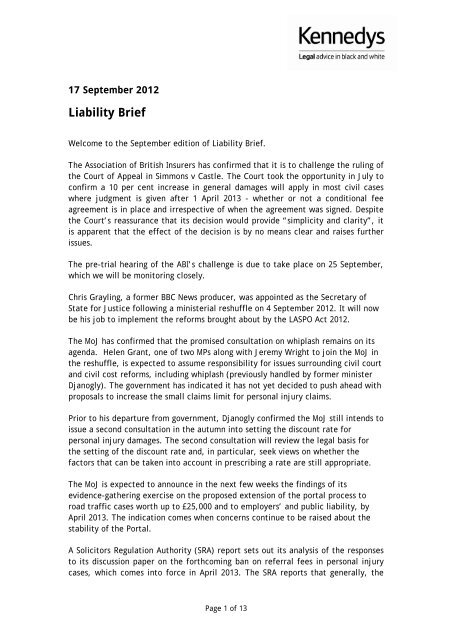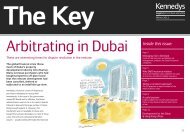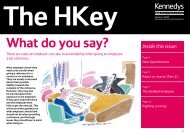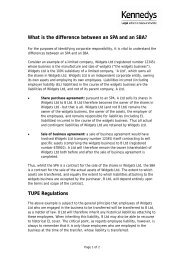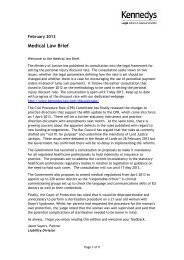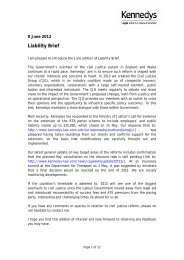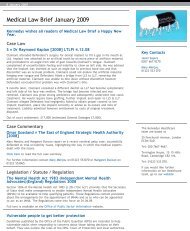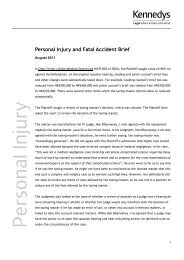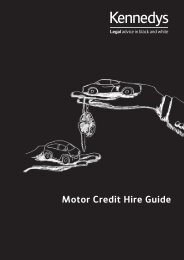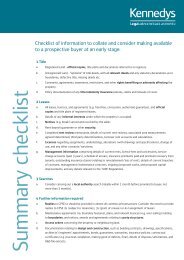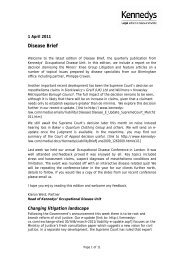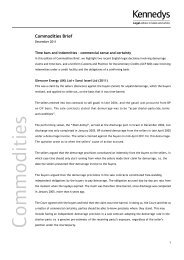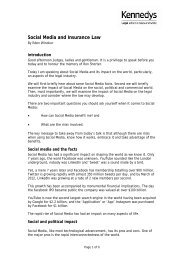Download Liability Brief - September 2012 (PDF, 63KB) - Kennedys
Download Liability Brief - September 2012 (PDF, 63KB) - Kennedys
Download Liability Brief - September 2012 (PDF, 63KB) - Kennedys
You also want an ePaper? Increase the reach of your titles
YUMPU automatically turns print PDFs into web optimized ePapers that Google loves.
17 <strong>September</strong> <strong>2012</strong><br />
<strong>Liability</strong> <strong>Brief</strong><br />
Welcome to the <strong>September</strong> edition of <strong>Liability</strong> <strong>Brief</strong>.<br />
The Association of British Insurers has confirmed that it is to challenge the ruling of<br />
the Court of Appeal in Simmons v Castle. The Court took the opportunity in July to<br />
confirm a 10 per cent increase in general damages will apply in most civil cases<br />
where judgment is given after 1 April 2013 - whether or not a conditional fee<br />
agreement is in place and irrespective of when the agreement was signed. Despite<br />
the Court’s reassurance that its decision would provide “simplicity and clarity”, it<br />
is apparent that the effect of the decision is by no means clear and raises further<br />
issues.<br />
The pre-trial hearing of the ABI’s challenge is due to take place on 25 <strong>September</strong>,<br />
which we will be monitoring closely.<br />
Chris Grayling, a former BBC News producer, was appointed as the Secretary of<br />
State for Justice following a ministerial reshuffle on 4 <strong>September</strong> <strong>2012</strong>. It will now<br />
be his job to implement the reforms brought about by the LASPO Act <strong>2012</strong>.<br />
The MoJ has confirmed that the promised consultation on whiplash remains on its<br />
agenda. Helen Grant, one of two MPs along with Jeremy Wright to join the MoJ in<br />
the reshuffle, is expected to assume responsibility for issues surrounding civil court<br />
and civil cost reforms, including whiplash (previously handled by former minister<br />
Djanogly). The government has indicated it has not yet decided to push ahead with<br />
proposals to increase the small claims limit for personal injury claims.<br />
Prior to his departure from government, Djanogly confirmed the MoJ still intends to<br />
issue a second consultation in the autumn into setting the discount rate for<br />
personal injury damages. The second consultation will review the legal basis for<br />
the setting of the discount rate and, in particular, seek views on whether the<br />
factors that can be taken into account in prescribing a rate are still appropriate.<br />
The MoJ is expected to announce in the next few weeks the findings of its<br />
evidence-gathering exercise on the proposed extension of the portal process to<br />
road traffic cases worth up to £25,000 and to employers’ and public liability, by<br />
April 2013. The indication comes when concerns continue to be raised about the<br />
stability of the Portal.<br />
A Solicitors Regulation Authority (SRA) report sets out its analysis of the responses<br />
to its discussion paper on the forthcoming ban on referral fees in personal injury<br />
cases, which comes into force in April 2013. The SRA reports that generally, the<br />
Page 1 of 13
discussion paper and the options discussed received positive feedback from<br />
respondents. The SRA will seek approval from the Legal Services Board for changes<br />
to its regulatory framework, prior to implementation, in early 2013.<br />
I hope that you enjoy this edition and welcome any feedback for future editions.<br />
Mark Burton,<br />
Partner<br />
Case reviews<br />
Duty of care: game at sporting event<br />
Court confirms that risk assessments cannot foresee all risks; social value of an<br />
activity has to be considered when deciding whether to allow an activity to<br />
continue - Cornish Glennroy Blair-Ford v CRS Adventures Limited [13.08.12].<br />
Comment<br />
This is another common sense decision where the Compensation Act 2006 has<br />
assisted a judge to find that tragic accidents can happen without fault. Section 1 of<br />
the Act is headed ‘Deterrent effect of potential liability’ and applies in relation to<br />
the management of activities of social value or, in the words of the Act, “desirable<br />
activity”.<br />
The intention of that provision is not to deter organisers of socially orientated<br />
activities by an overly rigid application of the health and safety regime applicable<br />
elsewhere. However, it should not be anticipated that similar latitude (exercised in<br />
this case in relation to risk assessment of a modified method of ‘welly wanging’)<br />
will be applied to liability assessment of work-place accidents. On the contrary, a<br />
strict application of the law on matters such as risk assessments will continue to be<br />
enforced by the courts and where only on the most exceptional facts will an<br />
accident be held to be without fault.<br />
Background<br />
The Claimant, a college teacher, participated in a one week adventure course at<br />
the Defendant’s country park. On the last day of the trip, the Claimant took part in<br />
a mini-Olympics activity of “welly-wanging”. This activity involved throwing a<br />
wellington boot as far as possible. During the event, the teachers were asked to<br />
throw the wellington boot between their legs so as not to put the children at a<br />
disadvantage. The Claimant threw the wellington boot with such force that he lost<br />
balance and landed on his head, suffering as a consequence a catastrophic spinal<br />
injury.<br />
A risk assessment had been carried out before the event but the Claimant alleged<br />
that the injury was a foreseeable consequence of the revised method of throwing<br />
Page 2 of 13
and the Defendant had breached its duty of care by failing to carry out a formal<br />
risk assessment on that method.<br />
Held<br />
Mr Justice Globe was satisfied that the Defendant operated a professionally run<br />
enterprise that provided immense social value. Globe J recognised the wellestablished<br />
principle that the social value of an activity is a relevant consideration,<br />
as confirmed in the case of The Scout Association v Barnes (2010) (a case in which<br />
<strong>Kennedys</strong> acted) - http://www.kennedys-law.com/casereview/scoutmeeting/]<br />
Globe J accepted that the mini-Olympics (and the activities within it) did not carry<br />
inherent danger that created licensing requirements. Nevertheless, the risk<br />
assessment documentation produced by the Defendant would have accorded with<br />
any such requirement(s).<br />
Globe J held that a formal risk assessment of the mini-Olympics event as a whole<br />
was satisfactory. The Defendant could not be criticised for not carrying out a<br />
formal risk assessment of the method for handicapping the teachers before the<br />
welly-wanging activity began. Globe J observed that formal risk assessments can,<br />
in any event, be a less effective tool where a lot of variables exist (as with the<br />
welly-wanging activity).<br />
The manner in which the Claimant sustained injury could not have been foreseen –<br />
there was no foreseeable real risk. Further, the risk which needed to be foreseen<br />
by the Defendant was the risk of serious injury and not just the risk of any injury.<br />
As such no steps were needed to have been taken to guard against it. The injury<br />
resulted from a tragic and freak accident for which no one was to blame.<br />
Related outdoor pursuits cases<br />
• See our case review on Harrison v Jagged Globe [<strong>2012</strong>] -<br />
http://www.kennedys-law.com/vicariousliabilityunauthorisedactivity/<br />
• See our case on Shaw v Fuller School [<strong>2012</strong>] http://www.kennedyslaw.com/casereview/schooltrainingexpedition/<br />
• See our case on Barnes v The Scout Association [2010]<br />
http://www.kennedys-law.com/casereview/scoutmeeting/<br />
For more information please contact Tim Wilson on +44 20 7667 9331 or email<br />
t.wilson@kennedys-law.com.<br />
Reclaiming compensation: proportionate recovery<br />
Court of Appeal confirms that insurers cannot reclaim compensation paid to an<br />
injured insured passenger who permitted non-insured driver to drive; s.151(8)<br />
Page 3 of 13
of the Road Traffic Act 1988 contravenes Community law – Churchill Insurance<br />
Company Ltd v Fitzgerald & Wilkinson; Evans v Cockayne & Equity Claims Ltd<br />
[24.08.12].<br />
Comment<br />
This decision confirms that where an insurer is liable to pay compensation in<br />
respect of a liability of an uninsured person, its entitlement to recovery under<br />
s.151(8) of the Road Traffic Act 1988 (RTA) now contains an exception. Where<br />
recovery is sought from a person who is the insured and who is entitled to<br />
compensation, “any recovery by the insurer must be proportionate and determined<br />
on the basis of the circumstances of the case”.<br />
However, the extent to which compensation can be reduced remains unanswered,<br />
which is arguably unfortunate.<br />
Background<br />
In Wilkinson, the insured named driver allowed Mr Fitzgerald to drive the car. Mr<br />
Fitzgerald lost control of the car and collided with another vehicle, causing Mr<br />
Wilkinson to suffer severe injuries. The insurer accepted that, by virtue of s.151(5)<br />
Road Traffic Act 1988 (RTA), it had to compensate Mr Wilkinson as the passenger.<br />
However, it argued that under s.151(8) RTA, it could reclaim the compensation on<br />
the basis that Mr Wilkinson had caused or permitted the use of the vehicle. At first<br />
instance, Mr Justice Blair found that s.151(8) RTA was in breach of Community law<br />
and the insurers were not allowed to reclaim the compensation.<br />
The facts of Evans were essentially the same. Ms Evans allowed Mr Cockayne to<br />
drive the motorcycle as an uninsured driver whilst she travelled as a pillion<br />
passenger. He drove into the back of a lorry and Ms Evans sustained serious<br />
injuries. However, at first instance, the court found that the insurers were allowed<br />
to reclaim the compensation under s.151(8) RTA.<br />
The Court of Appeal referred the matter to the Court of Justice of the European<br />
Union (CJEU) for a preliminary hearing on two key questions:<br />
1. If s.151(8) is construed so as to exclude an injured insured person from<br />
compensation when travelling as a passenger, when he has permitted an<br />
uninsured driver to drive the car, would Community law hold such an<br />
exclusion void and unenforceable?<br />
2. If so, can s.151(8) be interpreted in such a way as not to breach Community<br />
law?<br />
The CJEU found that Community law must be interpreted as precluding national<br />
rules whose effect is to omit automatically the requirement that the insurer should<br />
Page 4 of 13
compensate an insured passenger who is injured as a result of giving permission to<br />
an uninsured driver. It was irrelevant that the insured driver knew that the driver<br />
was uninsured, believed him to be insured or did not consider the question.<br />
With regard to the second question, the CJEU said “it is only in exceptional cases<br />
that the amount of compensation may be limited [by national rules]”.<br />
Held<br />
The Court of Appeal accepted that when the insured is the injured passenger, the<br />
effect of s.151 (8) is to limit the extent of insurance cover and as such, has to be<br />
consistent with Community law.<br />
The Court held that s.151(8) demands two pre-conditions be fulfilled before the<br />
insurer has the right to claim a civil indemnity from the insured. It has to be shown<br />
the insured “caused or permitted the use of the vehicle” and that the use “gave<br />
rise to the liability”. Accepting that further conditions could be added to allow the<br />
insurer to exercise the s.151(8) right, the Court accepted that any limit to the right<br />
to compensation could only exist in exceptional circumstances and had to be<br />
proportionate.<br />
See our article on reclaiming compensation paid to passenger -<br />
http://www.kennedys-law.com/casereview/reclaimingpassengercompensation/<br />
For more information please contact Kathy Dwyer on +44 1622 625 649 or email<br />
k.dwyer@kennedys-law.com.<br />
Duty to provide adequate supervision: injury at school<br />
A local authority was not liable for injury sustained by a pupil when he was hit<br />
by a golf club during a lesson; adequate supervision provided; the teacher could<br />
not have been expected to see every action of a group of pupils at all times -<br />
Hammersley-Gonsalves v Redcar & Cleveland Borough Council [13.07.12].<br />
Comment<br />
This case is a reassuring decision for local authorities and activity providers across<br />
England and Wales.<br />
Refreshingly the Court of Appeal was not swayed by the potentially emotive<br />
concerns of a 12 year old boy being hit in the face with a golf club. Rather, it<br />
placed great weight on the particular circumstances (age of pupils, previous similar<br />
instances, pupils behaviour generally etc) and the steps taken by the school to<br />
ensure the activity was carried out in a safe manner. The causation point raised by<br />
Lord Justice Rimer was far more straightforward: put simply, there was no<br />
evidence adduced that any further action by the supervising teacher would have<br />
prevented the accident.<br />
Page 5 of 13
I have discussed the case with a number of local authority clients and comfort is<br />
taken from the Court’s common sense application of duty, breach and causation to<br />
the specific circumstances surrounding the incident. The judgment is a useful<br />
reminder to defendants to consider two things:<br />
1. What further steps could reasonably have been taken,<br />
2. What difference (if any) such steps would have made to positively<br />
preventing the accident?<br />
Background<br />
During a school golf lesson, the 12 year old Claimant suffered a facial injury when a<br />
golf club was swung by another pupil. The group of 22 male pupils – all aged<br />
between 11 and 12 years - were being supervised by one teacher, Mr Fowle.<br />
The court at first instance found that Mr Fowle did not adequately supervise the<br />
pupils as he could not and did not see what his pupils were doing at the time.<br />
The Defendant appealed.<br />
Decision<br />
With Lord Justice Pill delivering the leading judgment, the appeal was upheld. The<br />
Court of Appeal held that the Defendant’s system of supervision was adequate in<br />
the circumstances. It found that, although the teacher could not see all the actions<br />
of all pupils at all times, this did not amount to negligent supervision. These pupils<br />
had undertaken previous golf lessons over the preceding six weeks and were well<br />
behaved generally, including on this occasion. The action of the pupil who swung<br />
his golf club, which hit the Claimant, was considered spontaneous and wholly<br />
unexpected.<br />
In relation to causation, the Court held that, on the balance of probabilities, no<br />
action by Mr Fowle would have prevented the accident. Further, the Court added a<br />
finding regarding the staffing ratio; finding that closer supervision of the group by<br />
having extra teachers was not reasonably required in the circumstances.<br />
For more information please contact Thom Lumley on +44 845 838 4886 or email<br />
t.lumley@kennedys-law.com.<br />
Landlord’s liability: slippery when wet<br />
A landlord did not owe a duty of care to her tenant who was injured by slipping<br />
on painted steps on her property; it was not unreasonable for a landlord to<br />
paint concrete steps with outdoor paint - Drysdale v Hedges [27.07.12]<br />
Page 6 of 13
Comment<br />
In this case, the Court found that the landlord owed no duty of care under the<br />
Occupiers <strong>Liability</strong> Act 1957 and the Defective Premises Act 1972 to her tenant.<br />
This is a decision that should reassure landlords who have to defend claims where<br />
accidents occur despite their best attempts to improve the property.<br />
The case follows long established principles and it is worth remembering that as a<br />
general rule, a landlord’s duty to repair kicks in once they have received notice of<br />
the defect. That being said, it is important to remember that s. 4 of the Defective<br />
Premises Act can apply if it was reasonable for the landlord to have known about<br />
the defect (such as where the defect is obvious) even without having been notified<br />
of the same.<br />
Background<br />
In October 2008, the Claimant slipped on the middle step leading up to the front<br />
door of the premises she rented from the Defendant. As a result of the slip she fell<br />
into the basement area of the house suffering serious back injuries. The Claimant<br />
alleged the steps were unduly slippery as a result of being painted and wet. She<br />
further alleged the Defendant had failed to provide a sufficiently high wall at the<br />
side of the steps and/or a handrail to prevent someone from falling down to the<br />
basement level.<br />
The Claimant alleged these failures breached s.2 of the Occupiers <strong>Liability</strong> Act<br />
1957 (1957 Act), s.4 of the Defective Premises Act 1972 (1972 Act) and/or the<br />
tenancy agreement and common law.<br />
Held<br />
Mr Leighton Williams QC accepted that painting the steps had increased the risk of<br />
slipping on the steps, particularly when the steps were wet. However, the Court<br />
was satisfied the 1957 Act had no application - a landlord’s duty of care should<br />
normally be confined to the 1972 Act. Accepting the Defendant was under an<br />
obligation to maintain or repair premises “not in good repair”, the Court<br />
considered that neither the stone steps nor the paint required repair. What was<br />
required was the removal of the paint and “it is stretching the meaning of the word<br />
“repair” to apply it to the removal of the paint.”<br />
Accordingly, the presence of the paint did not breach the 1972 Act or the tenancy<br />
agreement either. In which case, a landlord owes a common law duty to take<br />
reasonable care not to create an unnecessary risk of injury. With regard to the<br />
unguarded drop, the Court was satisfied the Defendant was not required to make<br />
safe the wall besides the steps as the unguarded drop pre-existed the Defendant’s<br />
purchase of the property. With regard to the painting of the steps, the Court held<br />
Page 7 of 13
the Defendant had applied a paint that was on the face of it suitable for the job in<br />
question and it was not unreasonable for her to have painted the steps.<br />
For more information please contact Nicole Baygan on +44 121 214 8023 or email<br />
n.baygan@kennedys-law.com.<br />
Feature articles<br />
Fifty shades of green<br />
Berent v (1) Family Mosaic Housing (2) London Borough of Islington [03.07.12]<br />
Robbins v London Borough of Bexley [16.08.12]<br />
It is estimated that the value of recoveries by property insurers resulting in tree<br />
root subsidence cases is well in excess of £100 million with the majority of the<br />
monies recovered from local authorities, who are either self insured for the<br />
majority of the claims or entirely. In light of the Comprehensive Spending Review<br />
<strong>2012</strong> (carried out by HM Treasury), cash strapped local authorities would be very<br />
keen to reduce the size of recoveries by property insurers. Indeed, in most cases,<br />
local authorities have abandoned their policy of preserving street trees in favour of<br />
removal and replanting upon being presented with a potential claim for damage by<br />
third party property insurers.<br />
The cost of failing to remove a tree resulting in sub-structure repairs (usually<br />
underpinning) can be ten times the cost of superstructure repairs.<br />
Two recent court decisions have re-visited liability for breach of duty, which has<br />
previously been a less contentious issue in light of strong decisions, which have<br />
largely gone in favour of the property insurers.<br />
Domestic insurers seeking a recovery would normally expect an admission of<br />
liability from local authorities or commercial property insurers in circumstances<br />
where they can demonstrate:<br />
<br />
<br />
<br />
<br />
<br />
The third party tree was within the recognised zone of influence<br />
The soil (usually London clay) was desiccated<br />
Live tree roots have been recovered from trial pits<br />
Monitoring establishes cyclical movement consistent with tree root activity<br />
There is no evidence of what precise steps the tree owner took to prevent<br />
or minimise the damage<br />
There may be a debate about the extent of the damage and alternative<br />
contributing factors, but essentially the points above have been the key<br />
determining factors.<br />
Page 8 of 13
The issue of breach of duty had largely been conceded in cases prior to the<br />
determination of the case in Berent v Family Mosaic Housing: namely that the local<br />
authority with trees within a zone of influence located in soil capable of becoming<br />
desiccated, and therefore with capacity to damage third party property and who<br />
took no or no adequate steps to prevent or minimise the property damage.<br />
Salient facts: Berent v Family Mosaic Housing<br />
1 The roots from two London plane trees allegedly caused damage to the<br />
Claimant’s property in 2003/2004<br />
2 Other potential causes of damage were considered, including a defective<br />
drainage system and vibration damage from railway tunnelling work<br />
3 The period of damage was reasonably short lived between <strong>September</strong> 2003<br />
and Spring 2004<br />
4. Notice was given to the Defendant Local Authority in 2009<br />
5. The trees were removed in 2011<br />
6. The expert evidence was that pruning would not have prevented the<br />
damage<br />
At first instance, the Court held that there was no proof that the Defendants could<br />
have appreciated the real risk of damage. The Court of Appeal’s judgment focused<br />
on liability for breach of duty and applied the well established test of: (i) to what<br />
extent could the consequence be reasonably foreseen (ii) to what extent action<br />
could be taken to eliminate the risk (iii) having consideration to the social<br />
desirability of that activity.<br />
The test has further been refined and put as “…the general principle [is] that a<br />
person must be regarded as negligent if he does not take steps to eliminate a risk<br />
which he knows or ought to know is a real risk and not a mere possibility which<br />
would never influence the mind of a reasonable man” (the Wagon Mound (1967)).<br />
Questions arising from that test are: how reasonable are these steps, how<br />
expensive will they be, and within what time scale could the party be expected to<br />
eliminate the risk, and how practicable are the steps necessary to eliminate the<br />
risk?<br />
The Decision<br />
Arboricultural evidence from the Claimant was that the only remedy was to remove<br />
the trees. The Defendant Local Authority had to balance its obligations pursuant to<br />
the Town & County Planning Acts and the amenity value placed on trees. There had<br />
been no evidence of historical damage caused by the offending trees. The Local<br />
Authority had a prudent regime of tree management and there was no evidence<br />
that it should have had a different regime. The Claimant’s expert’s opinion was<br />
that all trees growing near the property would have to be removed and the Court<br />
found this a less attractive argument. Further, the Claimant’s experts were not<br />
Page 9 of 13
able to identify the neighbourhood where damaged caused a particular area or<br />
“hotspot”.<br />
On balance the Court of Appeal found the steps necessary to prevent the risk of<br />
damage were disproportionate and contrary to the Local Authority’s obligations to<br />
preserve the amenity value of trees.<br />
Consequences of the decision<br />
<strong>Liability</strong> for breach of duty will no longer be largely conceded by local authorities.<br />
Provided they could demonstrate a reasonable tree maintenance policy backed by<br />
arboricultural expertise, the policy was implemented, and provided they have no<br />
reason to consider a particular tree or neighbourhood posed a higher than normal<br />
risk then potentially the claims could be defended.<br />
Insurers and local authorities do not have to wait long to test the application of<br />
foreseeability following this decision. The High Court was at the same preparing to<br />
hand down judgment in the case of Robbins v London Borough of Bexley (<strong>2012</strong>).<br />
Salient facts: Robbins v London Borough of Bexley<br />
1 Evidence of damage to the Claimant’s property in 2003 and 2006<br />
2 The Defendant’s poplar trees had been severely reduced, in all<br />
likelihood reducing the extent of movement to the Claimant’s property<br />
in 2006<br />
3 There was a large disagreement about whether the Defendant’s tree<br />
was within a foreseeable zone of influence<br />
4 Only one small root (less than 1mm in diameter) from the Defendant’s<br />
tree had been recovered from trial pits. It was largely accepted by the<br />
engineers that the property had been damaged by tree root activity<br />
5 The Claimant’s arboricutural evidence was preferred on all the crucial<br />
issues<br />
The decision<br />
The High Court held the Defendant Local Authority had not followed its own stated<br />
tree root policy and was liable for the damage that did occur. The decision was<br />
made in light of the evidence of earlier claims involving trees from Danson Park<br />
causing damage to neighbourhood properties (up to a distance of 35 metres), and<br />
the fact that the Court preferred the Claimant’s expert evidence that the roots<br />
were within the acceptable zone of influence capable of causing damage, The<br />
Local Authority had been aware of the potential risks of tree root damage to these<br />
properties since 1998, as they had been aware of the earlier claims and in fact<br />
settled some of them.<br />
The judgment was reserved pending the appeal in Berent. Upon hearing<br />
submissions, the High Court made it clear that there were no special principles of<br />
Page 10 of 13
law involved in tree roots cases in relation to the issues that arise in nuisance and<br />
negligence cases.<br />
In Robbins, the High Court was satisfied the trees had posed a foreseeable risk<br />
since 1998, and the Local Authority could have taken reasonable steps to eliminate<br />
that risk.<br />
Consequences<br />
Local authorities are likely to be more reluctant to concede the issue of liability.<br />
Insurers will need more evidence, which is likely to include:<br />
<br />
<br />
<br />
Evidence of a reasonable tree management policy, its reasonableness and<br />
proof of implementation<br />
History of claims and actions taken<br />
More use of expert witnesses especially arborculturist to comment on the<br />
tree maintenance programmes, zones of influence and alternative remedial<br />
action<br />
The question of foreseeability between domestic householders, namely, whether a<br />
domestic householder is in a different category in law from any other reasonably<br />
prudent tree owner is currently being considered in the case of Khan v Kane and a<br />
decision in this crucial case is awaited.<br />
Fifty shades of green may have become fifty shades lighter.<br />
Peer reviewed by Daniel Crowley, Barrister, 2 Temple Gardens<br />
For more information please contact Andrew Caplan on +44 845 838 4805 or email<br />
a.caplan@kennedys-law.com.<br />
Five ways for claimants to avoid personal injury litigation – by a<br />
defendant<br />
I recently wrote about ways for defendants to avoid personal injury litigation. As a<br />
follow up I thought it would be interesting to imagine that the ‘shoe was on the<br />
other foot’ and to consider the same objective from the claimant’s perspective.<br />
Here are my suggestions:<br />
1. Treat litigation as a last resort<br />
The three year limitation period gives sufficient time for most injuries to stabilise<br />
sufficiently for a final prognosis or for even the most complicated earnings models<br />
to be assessed. The pre-action protocol intends that litigation should be a last<br />
resort and that claims should not be issued prematurely when a settlement is still<br />
actively being explored. Where liability has been admitted, the claimant is<br />
supposed to disclose all medical reports and contact the defendant for a final<br />
"stocktake" at least 21 days before commencing proceedings. I have personally<br />
Page 11 of 13
never been approached for a stocktake, yet it is a very attractive idea. Most<br />
defendants would frankly much rather avoid the expense of unnecessary<br />
proceedings and will be delighted by the opportunity for pre-litigation settlement<br />
discussions.<br />
2. Play fair with experts<br />
The claimant has complete pre-litigation control over experts which can lead to<br />
some brinkmanship. At the worst extreme, the claimant exploits this situation to<br />
choose his favourite experts, collect reports behind the scenes, sit on them for a<br />
while, and then eventually disclose everything in one go and sometimes very close<br />
to limitation. The defendant will rarely accept these without question and the<br />
usual reaction is to ask for a second opinion from their own expert(s). The case<br />
then becomes entrenched whilst the defendant works to unpick the one sided<br />
reports. As an alternative, if the claimant is open about the expert road-map and<br />
circulates timely reports, the defendant is likely to be much less sceptical about<br />
whether the evidence is truly representative.<br />
3. Share information<br />
The psychology of a claim is that the claimant who keeps the defendant updated<br />
and volunteers a schedule of loss and medical reports comes across as more<br />
genuine than the claimant who is slow to produce documents, sits on reports for<br />
months, and belatedly serves an inflated schedule. Progressive claimant solicitors<br />
will trade information to advance their client's interests.<br />
4. Do not over-claim<br />
The system is at its most adversarial when the claimant over pleads the case for<br />
maximum negotiating room before conceding a realistic figure. We keep data that<br />
shows we are currently settling serious injury claims for about 40 per cent of the<br />
amount claimed, which means there is a 60 per cent mark-up. Unfortunately this<br />
approach significantly prolongs claims because the defendant is forced to work to<br />
bring the numbers back down to a fair and reasonable level, yet the claimant is<br />
rarely punished because of the lack of clearer costs sanctions for exaggeration.<br />
5. Make offers!<br />
I handle a lot of claims where the claimant never makes any Part 36 offers and the<br />
claim only settles through defendant offers or, eventually, a joint settlement<br />
meeting. I have never completely understood the reluctance of claimants to make<br />
offers, especially when they have the best information regarding the injury and<br />
financial losses and are in the best position to value the claim. I hope that the civil<br />
justice reforms will encourage more claimant offers – considering that they stand<br />
to gain a further 10 per cent of damages (up to a cap of £75,000) for beating their<br />
Page 12 of 13
own offers and that defendants may consider economic settlements because of the<br />
QOCS shield.<br />
Conclusions<br />
Apart from cases where the claimant instructs solicitors close to expiry of the<br />
limitation period and proceedings are unavoidable through lack of time, most other<br />
cases should be capable of resolution without proceedings. The key ingredients are<br />
that the claimant is reasonable about evidence, the defendant is reasonable about<br />
interim payments when required, and both are prepared to engage with the other<br />
and make realistic offers.<br />
Read “10 ways for defendants to avoid personal injury litigation” in the August<br />
<strong>Liability</strong> <strong>Brief</strong>: http://www.kennedyslaw.com/article/toptenwaystoavoidpersonalinjurylitigation/<br />
For more information please contact Mark Burton on +44 20 7667 9356 or email<br />
m.burton@kennedys-law.com.<br />
<strong>Kennedys</strong> is a trading name of <strong>Kennedys</strong> Law LLP. <strong>Kennedys</strong> Law LLP is a limited liability partnership<br />
registered in England and Wales (with registered number OC353214).<br />
Page 13 of 13


